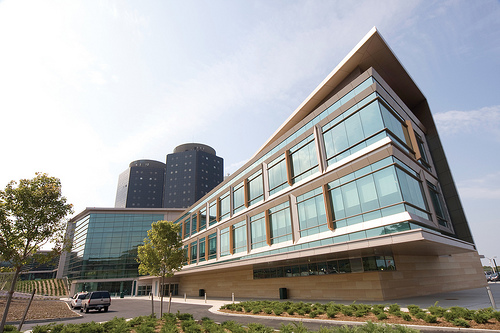 |
| Stony Brook University Medical Center (SBUMC) is the only academic medical center on Long Island, New York and Suffolk County’s only Level 1 Trauma Center. |
When it comes to eco-stewardship, Long Island’s Stony Brook University Hospital (SBUH) is a pioneer. In fact, it is the nation’s first hospital to pledge to reduce its environmental impact with the U.S. Environmental Protection Agency. The EPA agreement is the cornerstone of an August 2009 Memorandum of Understanding that outlines goals and strategies for energy and water conservation, solid waste management, green design, and the use of environmentally-friendly products.
It is noteworthy that Call2Recycle® was included in the SBUH/EPA pledge as the vehicle for rechargeable battery and cellphone recycling.
Carol Ann Malley is the Hospital Environmental Manager in the Department of Environmental Health & Safety. She administers the Hospital’s hazardous waste, laboratory safety, and environmental protection programs. Staff from the Department of Environmental Health & Safety learned about Call2Recycle during the 2008 CleanMed Conference. Carol was intrigued that Call2Recycle’s turnkey rechargeable battery and cellphone recycling program was so easy… and free. Before partnering with Call2Recycle in June 2009, SBUH collected its spent batteries in unwieldy 55-gallon drums as part of the hazardous waste service contract. The battery collection drums were isolated on the Hospital campus, difficult to move, and expensive to ship. For a university hospital that generates large quantities of spent batteries from two-way radios, biomedical equipments, power tools and laptops, the recycling procedure was in need of improvement.
“Call2Recycle provided us with multiple boxes so we could locate them in high-use areas throughout the hospital and our off-site clinics,” said Malley. Battery collection boxes have been placed in the Biomedical Engineering department as well as in the Physical Plant, Central Sterile Supply area, and staff offices. SBUH fills three to four boxes per month, totaling 984 pounds collected from June through December 2009. “There’s a lot to like about Call2Recycle,” Malley said. “I appreciate the fact that Call2Recycle tracks our battery waste and reports the collected poundage. The instructions on the boxes are clear, collection bags are provided, and we don’t have to sort battery chemistries. Plus, UPS shipment of filled boxes is free.” Not only is the process much easier than the previous large-drum system, Call2Recycle is projected to save SBUH approximately $2,000 per year in operating costs.
| SBUH’s Biomedical Engineering staff embraces rechargeable battery recycling |
Carol Malley and hospital staff actively promote rechargeable battery recycling at SBUH. Malley also conducts monthly training for the Hospital’s laboratory staff, encourages staff members to search for spent batteries during health and safety inspections, discusses the program in the Hazardous Materials and Waste subcommittee, and will feature Call2Recycle in the hospital’s Environment of Care newsletter. Call2Recycle was showcased at an Earth Day exhibit in the SBUH lobby and was highlighted in the hospital’s Environment of Care annual report.
The Hospital’s stance on green stewardship includes membership in Energy Star and Waste Wise as well as the aforementioned impact agreement with the EPA. The Call2Recycle partnership is an added advantage. “Not only is Call2Recycle easy, it’s made our employees more responsive to battery recycling,” Malley pointed out. “It facilitates SBUH compliance with hazardous waste regulation. That’s very important to us.”
###
ShareMAY